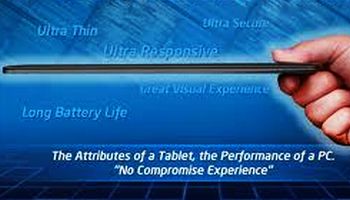Executives at Intel are reportedly continuing to work with suppliers in an effort to drive down the price of ultrabooks.
Navin Shenoy, vice president of sales and marketing and general manager for the Asia-Pacific region for Intel, told Reuters that company officials understand the need for driving down the price of ultrabooks to make them more competitive with Apple’s MacBook Pro and various tablet PCs on the market.
Doing so will mean greater cooperation from the various players in the supply chain, from suppliers to manufacturers.
Price Challenge
Price will be a key driver if Intel is to meet its goal of having ultrabooks account for 40 percent of all notebooks shipped by the end of 2012.
“That’s a challenging target. … In order for that to happen, the price has to come down,” Shenoy told the news organisation. “At some point, you’ll have to be at that price point, but it doesn’t have to be overnight. It takes time to engineer a cost down. … More work needs to happen in the ecosystem. Even if we’re giving the chips away for free, we couldn’t hit the price point we want to hit if we don’t work with the rest of the industry.”
 Acer and Asus are the first OEMs to release ultrabooks, which Intel sees as a way of not only boosting a PC industry under siege from increasingly popular tablets, but also another vehicle to grow the chip maker’s presence in the mobile device market.
Acer and Asus are the first OEMs to release ultrabooks, which Intel sees as a way of not only boosting a PC industry under siege from increasingly popular tablets, but also another vehicle to grow the chip maker’s presence in the mobile device market.
The least expensive of these is $899 (£561), with other models for selling well north of $1,000 (£624).
Uphill Battle?
Intel’s vision for ultrabooks is one of devices that are thin – less than 0.8-inches thick – and offer the benefits of traditional laptops with the features of tablets, including long battery life, instant-on and always-connected capabilities, and – eventually – touch-screens.
Price has been a key concern. Intel executives have said ultrabooks must be less than $1,000, but some in the industry have questioned how easily that can be done.
Intel CEO Paul Otellini, during an 18 October call with analysts and journalists to report the company’s quarterly financial earnings, acknowledged the price issue, and said the key will be suppliers and manufacturers being able to reduce the costs of their products. Helping them do that is the goal behind the $300 million (£187m) fund Intel has created for software and hardware companies developing products for the ultrabook form factor, Otellini said.
Dropping the price below $1,000 will enable ultrabooks to compete better against the MacBook Pro – whose least expensive model costs $999 – and tablets.
Intel officials see stages of development for ultrabooks, starting with this first round of systems that will run on the chip maker’s Sandy Bridge processors. Next year, systems based on Intel’s upcoming “Ivy Bridge” platform will begin hitting the market. The step after that will come in 2013, with the release of Intel’s “Haswell” chips. Each new chip platform promises greater performance, more features and better energy efficiency, Intel officials said.





